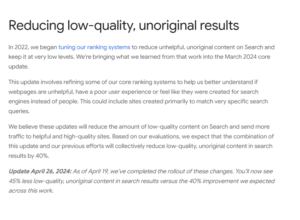Creating unique content for SEO is essential because search engines prioritise fresh, original content that adds value to users.
But what exactly does unique content mean? And how do you create content that is unique?
In this guide, we’ll break down:
– What unique content means
– Why it’s important
– How to create unique content that drives organic traffic
Need a SEO content strategy that actually drives results? Our content writing services help businesses create unique, optimised content that ranks.
What Does Unique Content Mean?
Search engines can tell when content is duplicated. Their crawlers index your text and compare it to other content across the web using algorithms. If Google finds that your page’s content also exists on another site (or even on another page of your own site), it usually won’t show both.
Typically, Google will filter out the duplicates and favour the page it thinks is the original or most relevant source. In fact, Google’s algorithms are known to push up unique content. Below is a snippet from Google’s official blog around how they are tackling low quality content:

It’s important to realise that “unique” isn’t just about wording things in a different way – it’s about unique value. Two pages might use different wording but deliver the same basic information; such content isn’t providing a new benefit to the reader.
Truly unique content offers something fresh: a new insight, an original research finding, or a personal perspective that hasn’t been shared elsewhere.
In Short, What Makes Content Unique?
- Originality: Not rewritten or republished from another website.
- Depth & Value: Covers a topic in more detail than competitors.
Here is Google’s guideline for creating unique content.
AI-Generated Content – Can It Be Unique?
With AI content tools like ChatGPT becoming popular, many people ask if AI content can actually be unique. The short answer? It depends. AI-generated content still requires human editing, fact-checking, and originality to avoid sounding generic or repetitive.
Why Unique Content is Important for SEO
Google’s algorithms are designed to prioritise valuable, original, and user-focused content, so if your content stands out, provides value, and engages users, it’s far more likely to rank higher in search results.
Let’s go into more detail on why unique content is important:
1. Google Prioritises Unique, High-Quality Content
Google’s Search Quality Evaluator Guidelines make one thing clear: quality and originality matter. The search engine’s E-E-A-T principles (Experience, Expertise, Authoritativeness, and Trustworthiness) mean that pages offering genuinely unique insights are far more likely to rank than generic, regurgitated content.
💡 Example: If five websites publish articles on “How to calculate solar panel output,” Google will prioritise the most in-depth, original, and helpful article. In this instance, it may contain a calculator, or simple equations you can do to calculate it yourself.
Below is a snippet from Google’s Search Quality Evaluator Guidelines explaining how they determine the quality of a page:

2. Unique Content Boosts Rankings & Organic Traffic
One of the biggest SEO benefits of unique content is its direct impact on search engine rankings. If your content provides:
- New, valuable insights.
- Comprehensive, well-researched information.
- Engaging, user-focused answers to search queries.
- Link-baiting assets like calculators or other useful resources.
Then search engines often reward your efforts with higher visibility in search results.
How Unique Content Improves SEO Performance:
– Increases dwell time – Users stay longer on pages that offer genuinely useful information.
– Improves search rankings – Google promotes pages that provide unique value over competitors.
– Attracts backlinks – High-quality content earns more inbound links.
3. Helps You Stand Out in Competitive Markets
No matter your industry, you’re competing for visibility. If your content is just another version of what’s already ranking, why would Google (or users) choose you over competitors?
By focusing on unique content creation, you can:
- Build your brand authority – Position yourself as an expert on your topic.
- Create a competitive advantage – Offer something competitors haven’t covered.
- Increase audience trust & engagement – People engage more with content that feels fresh, authentic, and valuable.
4. Reduces Bounce Rate & Increases User Engagement
Unique content isn’t just good for SEO, but it’s also good for user experience (UX), too. When users land on a page, they expect new, useful, and engaging information. If they’ve seen the same content before, they’ll most likely leave.
How Unique Content Improves Engagement Metrics
- Encourages users to explore – If your content is valuable, users are more likely to click through other pages.
- Increases dwell time – The longer visitors stay, the stronger the SEO signal to Google.
- Reduces bounce rate – Unique, well-structured content keeps people engaged and reading.
5. Unique Content is Key for Backlink & Authority Building
Other websites are far more likely to link to you if you have something original worth citing. A guide or research piece that offers new insights can become a reference for others, earning you backlinks. Those inbound links, in turn, boost your site’s authority because users are finding answers to their queries.
Example: A data-driven blog post with original research is far more likely to be shared, linked to, and referenced than a basic rehash of existing content.
6. Google’s Algorithm Updates Prioritise Unique Content
Google constantly refines its ranking algorithms, and every major update reinforces one principle:
Websites that prioritise unique, high-quality content rank higher.
With updates like:
- Helpful Content Update – Rewards original, valuable content while demoting AI-generated or low-quality pages.
- E-E-A-T (Experience, Expertise, Authoritativeness, Trustworthiness) – Prioritises genuine, experience-driven content over generic copywriting.
- Core Updates – Regularly penalise duplicate, low-value content and push unique sources higher.
Pro Tip: If your website relies too much on thin, duplicate, or AI-generated content, it may get hit in future Google updates. Prioritising unique content is the safest long-term SEO content strategy.
Our Tips on How to Create Unique Content
Creating unique content may sound challenging, but with the right approach, it becomes achievable. Here are some actionable tips on how to create unique content:
1) Thorough Research and Add Your Own Spin
Research what content already exists for your topic, then figure out how to make yours different. Read the top-ranking articles to see what’s commonly covered. Identify information gaps or angles that others missed, and focus on filling those.
By covering the basics and providing something extra – a new example, an updated fact, or your own insight – your content will automatically become more unique.
2) Understand User Intent
Always clarify what the reader is looking for. Are they seeking a quick answer, an in-depth tutorial, a comparison, or expert advice? Tailor your content to fulfill that intent completely.
If you meet the user’s needs better than other available pages (for example, by answering questions others barely address), your content will stand out and satisfy both the user and the search engine.
Here are the 4 most common types of intent we come across:
- Informational Intent – Users looking for knowledge.
- Navigational Intent – Users searching for a specific brand or website.
- Commercial Intent – Users comparing options before buying.
- Transactional Intent – Users ready to take action.
3) Avoid Plagiarism
Never copy someone else’s text without proper quotes and credits. If you find yourself borrowing wording, take a step back and rephrase it in your own words or add your unique take. Similarly, avoid using automated “article spinners” to rewrite content – they might escape a simple plagiarism check, but the result will read oddly and fail to provide real value. The goal is genuine originality, not just to trick algorithms.
4) Use Related Keywords and Synonyms
Modern search engines use advanced Natural Language Processing (NLP) to evaluate content, which means they understand far more than just individual keywords. Google’s machine learning algorithms – such as RankBrain and BERT – analyse the context and intent behind the words on your page.
This has a direct impact on content strategy: how you write and cover a topic can influence your rankings. If you create unique content that thoroughly and naturally addresses a subject, the algorithms are likely to recognise its relevance.
For example, using a variety of related terms and synonyms (often called LSI keywords in SEO) helps show that you’re covering the topic comprehensively.
5) Provide Concrete Examples or Data
Wherever you can, include specific examples, case studies, or your own data. Real-world examples (like a brief case study or story) make your content more engaging and give the user proof that you actually are an expert on the topic you’re writing about.
If you have original research, statistics, or personal experience on the topic, share it – that’s content no one else can duplicate. Even a simple, unique example or metaphor can set your explanation apart from generic ones on other sites.
6) Incorporate Infographics
Use images, infographics, or videos to add unique value to your page. A custom diagram, a chart you made, or even photos you took can make your content different from text-only articles on the same subject.
Multimedia elements can also increase user engagement, which can improve how people perceive the quality of your content. Just make sure any images or videos you use are relevant and appropriately described with alt text.
7) Keep Content Up-to-Date
Update your content periodically to keep it unique and relevant. Over time, information can become outdated or widely copied by others. Regular updates also signal to search engines that your content is current and being actively maintained, which can help your SEO.
Struggling to Stand Out? We’ll Take Your SEO to the Next Level
Creating unique content for SEO isn’t just about ranking higher (although it’s a nice side effect of creating really good content), but it’s more about attracting the right audience, driving engagement, and turning visitors into paying customers. But let’s be honest, crafting high-quality, original content that actually performs takes time, effort, and expertise.
At Climb & Conquer, we don’t just write content – we are an SEO agency that creates SEO-driven, user-focused content strategies that help businesses dominate the search results and convert website visitors into customers.
Want to build content that ranks and converts? Check out our content writing services
OR
Explore more of our SEO services




